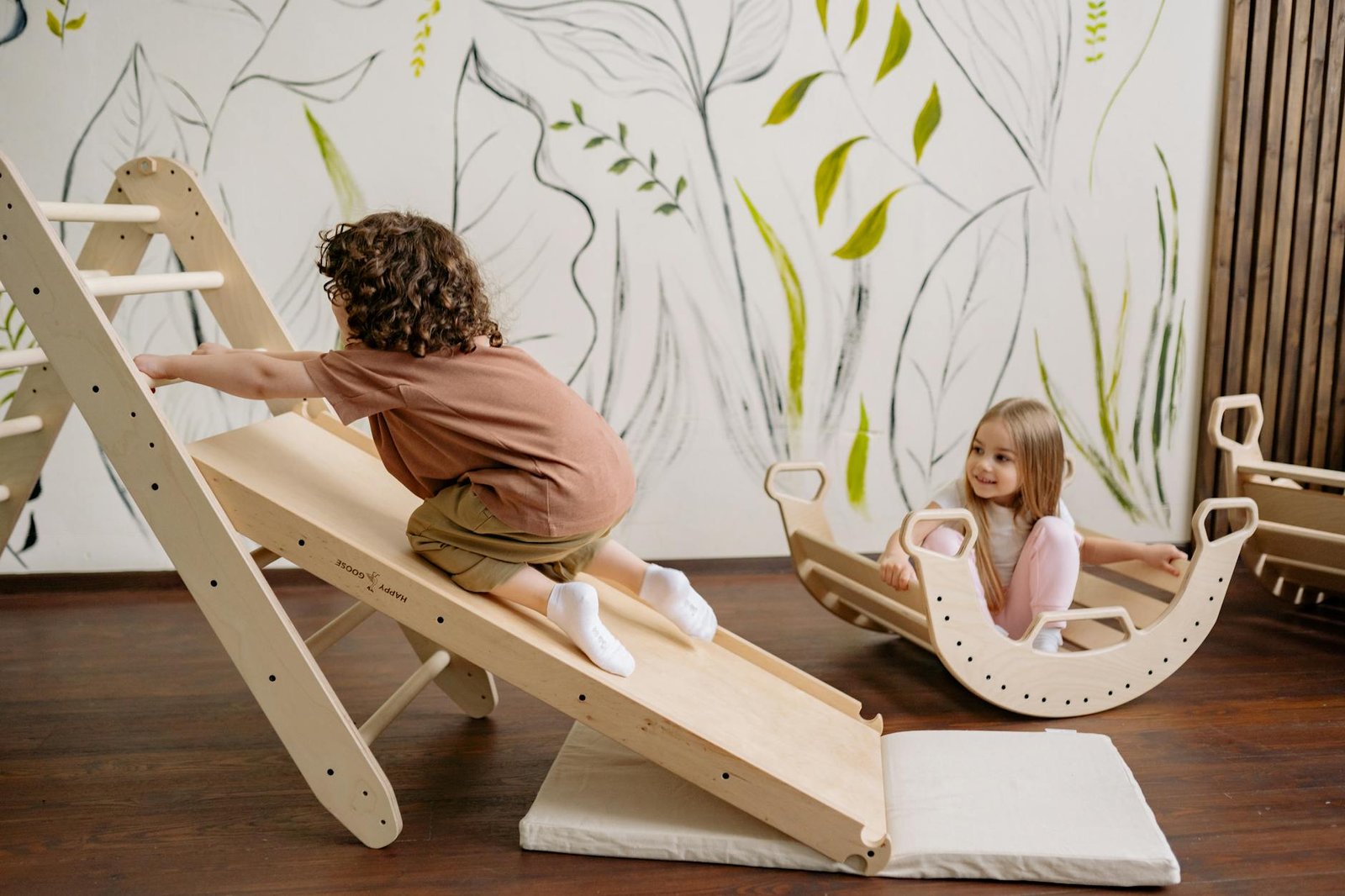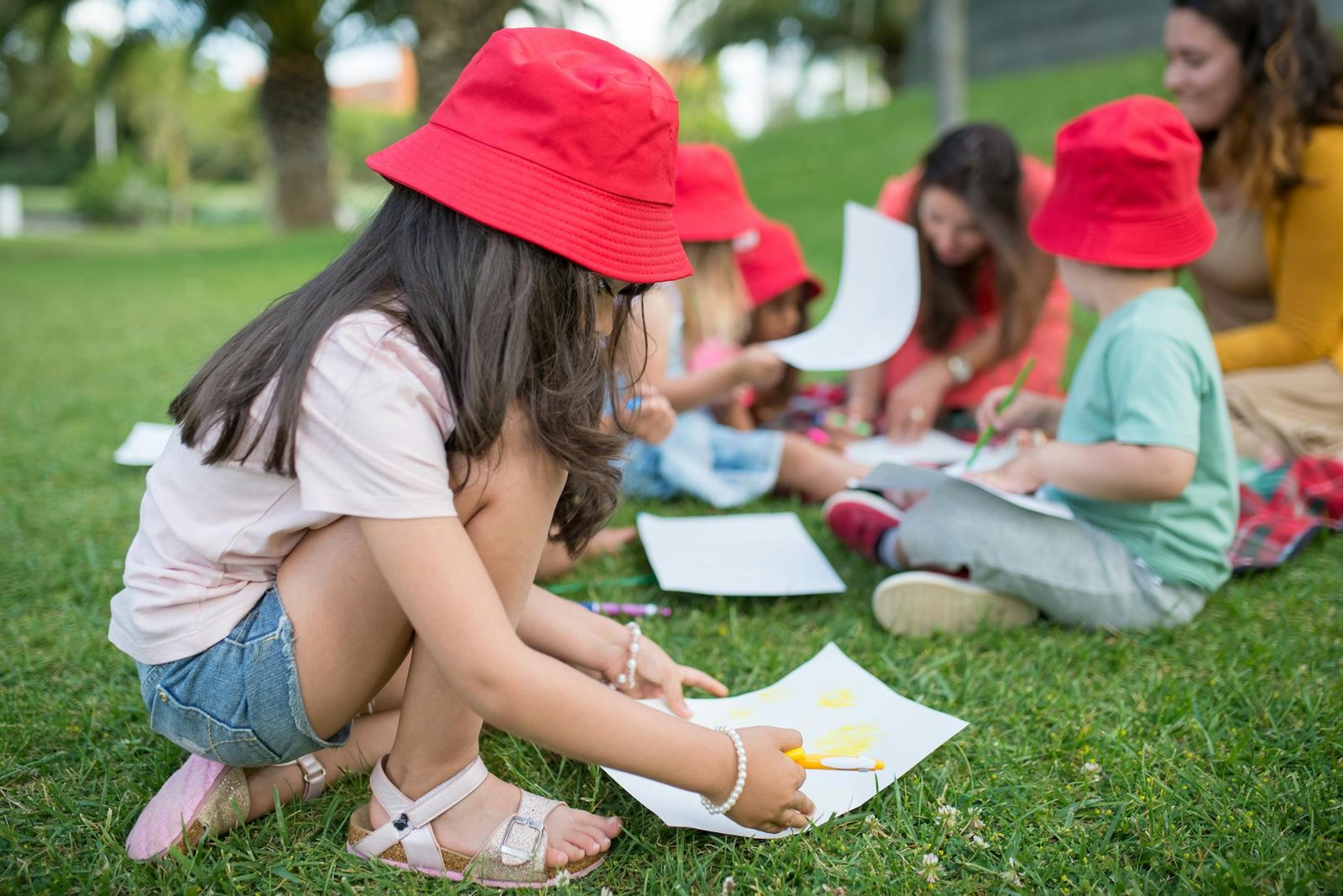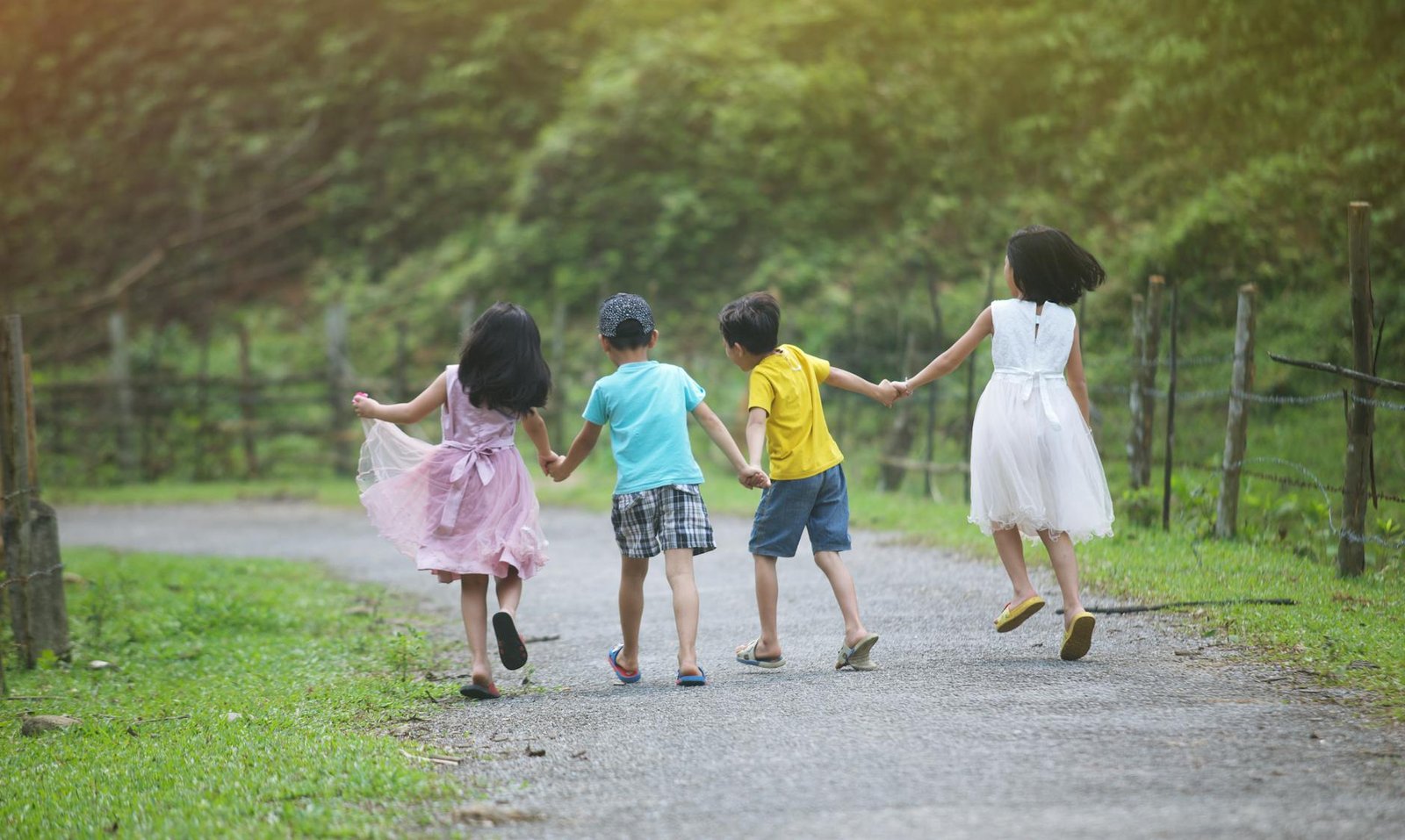7 Fun Ways to Make Friends for Kids Ages 4–8
Ever watched your kid freeze up at the playground, standing alone while other children laugh and play? It’s heartbreaking. But here’s the thing: making friends isn’t something kids automatically know how to do.
The good news? Friendship skills can be taught, just like tying shoes or saying “please.”
Teaching kids how to make friends isn’t helicopter parenting—it’s giving them tools they’ll use their entire lives. With the right approach, you can help your child build those critical social connections without stepping in to manage every interaction.
So what exactly should you be doing to guide your 4-8 year old toward making meaningful friendships? The answer might surprise you…
Playground Activities That Build Friendships

Playground Activities That Build Friendships
A. Organizing Inclusive Games Anyone Can Play
Games that welcome every child build the strongest friendships. Think about simple games like “Duck, Duck, Goose” or “Red Light, Green Light” where rules are easy to follow and nobody sits out for long. The magic happens when you tweak familiar games to make sure everyone gets equal turns.
Just like in many children’s story books about friendship, the goal isn’t winning—it’s playing together. Try “Friendship Tag” where tagged players join hands with the tagger, creating a growing chain of friends. The game creates natural teamwork and lots of giggles.
B. Creating “Buddy Benches” for Kids Looking for Playmates
Buddy benches are game-changers! This special bench on the playground signals “I want someone to play with.” When a child sits there, others know to invite them to join activities.
Many schools report buddy benches reducing loneliness instantly. Kids learn to spot when someone needs a friend—just like characters in their favorite children’s story books about friendship who notice when someone feels left out.
C. Group Games That Teach Cooperation
Parachute games are perfect for teaching kids to work together. Everyone holds the edges of a colorful parachute, following directions to make waves, mushrooms, or roll balls across the fabric.
Another winner? Obstacle courses where kids must help each other through. These activities show children that reaching goals together feels even better than doing it alone.
D. How Time on Playground Equipment Develops Social Skills
Swings, slides, and climbing structures aren’t just for physical fun—they’re friendship factories! Taking turns on the slide teaches patience. Pushing someone on a swing teaches giving. The monkey bars? Perfect for encouraging words and helping hands.
When kids navigate playground equipment together, they practice real-life social skills that build lasting friendships.
Friendship-Building Through Creativity

Group Art Projects That Strengthen Bonds
Kids love making things, and they love it even more when they do it with friends! Group art projects give children a chance to work together toward a common goal, building trust and cooperation along the way.
Try setting up a giant mural where each child contributes their piece. Roll out butcher paper across the floor and let them create a neighborhood or underwater scene together. When kids collaborate on art, they learn to share space, materials, and ideas.
“My favorite part about our class mural was when Jake helped me draw a really big fish,” says 6-year-old Mia. “I couldn’t make the tail right, and he showed me how.”
Collaborative Storytelling Techniques
Stories bring kids together like magic! Create a “story circle” where each child adds one sentence to an ongoing tale. You’ll be amazed at the creativity that flows.
For younger kids, use picture books about friendship as jumping-off points. After reading a children’s story book about friendship, ask them to create their own adventure with the characters.
“The round-robin stories make my shy son laugh so hard,” shares parent Jamie Moore. “He waits for his turn and gets so excited to add his part.”
Music and Dance Activities for Social Connection
Nothing breaks down barriers faster than dancing silly or making music together! Freeze dance, musical chairs, and simple choreographed routines help kids connect through movement.
Create a homemade band with pots, pans, and wooden spoons. The shared rhythm helps children feel in sync with each other. When they’re making music together, they’re learning to listen and respond to others.
Building Things Together: From Blocks to Forts
Watch friendship bloom when kids construct something as a team. Whether it’s a towering block structure, a LEGO masterpiece, or a blanket fort, building activities teach cooperation and problem-solving.
“When we made our big cardboard castle, I had to hold the walls while Tommy taped them,” recalls 7-year-old Zoe. “We couldn’t do it alone!”
Puppet Play for Expressing Feelings
Puppets give kids a safe way to express themselves and practice social skills. Create simple sock puppets and let children act out scenarios about making friends, sharing, or resolving conflicts.
Puppet plays help children step into others’ shoes and understand different perspectives. They’re practicing empathy while having fun!
Structured Social Activities for Shy Children

Small Playdates with Clear Activities
Shy kids often feel overwhelmed in big groups. The solution? Mini playdates with just one or two other children where everyone knows exactly what they’re doing.
Set up a simple craft station, a building block challenge, or a treasure hunt with clear instructions. When shy children know what’s expected, they can focus on the friendship rather than worrying about what comes next.
Try saying, “Today we’re making sock puppets, then using them for a show!” This structure gives your child confidence because there’s no mystery about what’s happening.
Limit these playdates to about an hour for younger kids. Longer isn’t always better – quality interaction beats quantity every time!
Role-Playing Games That Develop Social Scripts
Shy kids sometimes freeze because they don’t know what to say. Role-playing games are perfect for practicing social interactions in a fun way!
Have your child pretend to be a shopkeeper, doctor, or teacher. These scenarios give them ready-made “scripts” to follow, making social exchanges predictable and less scary.
“Playing restaurant helped Maya learn how to ask questions,” one mom told me. “Now she uses those same phrases with real friends!”
Using Children’s Books About Friendship as Guides
Children’s story books about friendship aren’t just bedtime entertainment – they’re social roadmaps! Books show kids exactly how friendships form, what to say, and how to solve common problems.
After reading, ask questions like, “What did the bunny do when he wanted to play with the bear?” Then practice those same techniques during playtime.
Great titles include “Will You Be My Friend?” and “How to Make Friends with a Dragon.” These stories provide conversation starters and show shy children they’re not alone in feeling nervous about making friends.
Teaching Kids to Be Good Friends

Simple Conversation Starters for Young Children
Kids often struggle with finding the right words to start a friendship. Give your child these easy conversation starters to practice at home:
- “I like your shoes. What’s your favorite color?”
- “Want to play with this toy together?”
- “Can I join your game?”
Role-play these scenarios at home where your child practices introducing themselves to a “new friend” (you or a stuffed animal). This builds confidence they can use on the playground.
Practicing Taking Turns and Sharing
Sharing doesn’t come naturally to young children. Try these fun games that make taking turns the whole point:
- Pass-the-drawing: Start a picture and take turns adding to it
- Board games with clear turn-taking rules
- Timer games where each child gets exactly 2 minutes with a special toy
Remember to praise the process: “I love how you waited until Sarah was finished before taking your turn!”
Learning to Listen to Others
Good friends listen. Help your child develop this skill by:
- Playing “repeat after me” games where they must listen carefully
- Reading children’s story books about friendship and asking what characters are feeling
- Practicing eye contact during conversations
Resolving Disagreements Positively
Conflicts happen, but they’re learning opportunities. Teach your child to:
- Use “I feel” statements instead of blame
- Take deep breaths when upset
- Find compromises like “We’ll play your game first, then mine”
Create a “friendship toolkit” with visual reminders of these skills your child can reference.
Using Technology Wisely for Social Connection

Virtual Playdates That Actually Work
Screen time doesn’t have to be solo time! Virtual playdates can be fantastic when you set them up right. Instead of just waving at the camera, try reading a children’s story book about friendship together—one child starts the page, then the other continues. My favorite trick? Send the same craft supplies to both homes beforehand so kids can create together while chatting. The key is keeping these sessions short (20-30 minutes tops) and having a clear activity planned.
Age-Appropriate Online Activities for Friends
Not all online activities are created equal. For 4-5 year olds, shared storytelling apps where they can take turns adding to a tale about friendship work wonders. Kids aged 6-8 might enjoy virtual scavenger hunts (“Find something blue and bring it back to the screen!”) or show-and-tell sessions with treasured toys. Always preview any platform before letting your child use it, and stick around during the first few sessions to guide them.
Digital Games That Promote Cooperation
Skip the competitive games and go for cooperative ones! Apps like “Toca Tea Party” or “Drawing Together” encourage kids to work as a team rather than against each other. Games where players build something together or solve puzzles as a group teach valuable social skills. The bonus? When they meet in person, they’ll already have shared experiences to build upon—just like characters in their favorite children’s story book about friendship.
Community and Group Activities That Foster Friendships

Community and Group Activities That Foster Friendships
A. Kid-Friendly Volunteering Opportunities
Nothing builds bonds faster than helping others together! Kids ages 4-8 can join beach cleanups where they pick up trash in teams, or participate in community garden projects planting flowers side by side. Animal shelters often welcome young helpers to socialize kittens or make simple toys for dogs. These activities teach children that friendship grows stronger when working toward a common good.
B. Sports Teams for Beginning Social Athletes
T-ball, soccer tots, and swim clubs are perfect for little ones just starting their athletic journey. The beauty? They focus more on fun than competition. Kids learn to cheer for teammates, pass the ball, and high-five after games. Coaches create space for friendship by rotating partners and organizing team snack duties. Even the shyest kids open up when celebrating a goal together!
C. Library Programs and Reading Circles
Libraries are friendship goldmines! Story time circles get kids giggling over the same tales (bonus points if they feature a children’s story book about friendship). Book character parties let kids dress up and bond over favorite characters. Many libraries also run summer reading buddies programs where kids track their progress together and earn shared rewards.
D. Nature Clubs and Outdoor Adventures
Kids who explore together, stay together! Junior ranger programs at parks teach children to work as teams identifying plants and animals. Scavenger hunts turn nature walks into exciting shared adventures. Kids naturally collaborate to climb logs, build forts, or observe insects in jars. These shared discoveries create lasting friendship memories.
E. Children’s Museums and Group Learning
Interactive exhibits become friendship laboratories when kids figure them out together. Many museums offer guided group activities where children build simple machines, create art, or solve puzzles as teams. The excitement of pushing buttons, turning cranks, and making discoveries together breaks down social barriers instantly!
Supporting Your Child’s Budding Friendships

How to Arrange Successful Playdates
Listen, playdates don’t need to be complicated! Start small with just one friend for about an hour. Watch how little ones light up when reading a children’s story book about friendship before their friend arrives—it sets the perfect tone.
Give kids a choice in who they invite, but have a backup plan if that friend can’t make it. A simple structure works best: free play, a small activity (like making friendship bracelets), and a light snack. Don’t overschedule—kids need space to let their imaginations run wild together.
Pay attention to timing too. Skip playdates when your child is hungry or tired—that’s just asking for meltdowns.
Recognizing and Respecting Friendship Styles
Some kids make friends everywhere they go. Others prefer one close buddy. Both are totally normal! Your job? Accept your child’s natural style without pushing them to be someone they’re not.
Shy kids might need gentle encouragement, but forcing them into big social situations can backfire. Notice what makes your child comfortable—maybe they thrive in smaller groups or need activity-based hangouts rather than open-ended play.
Creating a Friendship-Friendly Home Environment
Your home should feel welcoming to little visitors! Keep a basket of toys that work well for sharing, like building blocks or art supplies. Having a dedicated play area helps, but don’t stress if space is tight.
Set simple house rules that everyone understands. Kids feel secure when they know what’s expected.
When and How to Step Back and Let Friendships Grow
Hovering over every interaction doesn’t help kids develop social skills. Once you’re sure they’re safe, give them some breathing room. Maybe stay nearby but busy yourself with something else.
When conflicts pop up (and they will), resist jumping in immediately. Kids learn valuable lessons when they work through disagreements themselves. Step in only when absolutely necessary, and even then, try guiding rather than solving.
Developing social skills and building friendships is a crucial aspect of childhood development. From playground interactions to creative activities, and from structured programs to community events, there are numerous ways to help children ages 4-8 connect with peers. Teaching empathy, sharing, and communication fundamentals while balancing technology use creates well-rounded social experiences for young children.
As parents and caregivers, your role in supporting these friendships is invaluable. By creating opportunities for social interaction, modeling healthy relationship behaviors, and offering gentle guidance when needed, you can help your child build a foundation of social skills that will benefit them throughout life. Remember that each child develops at their own pace—celebrate small successes and be patient as your child navigates the rewarding journey of making friends.
















